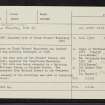Following the launch of trove.scot in February 2025 we are now planning the retiral of some of our webservices. Canmore will be switched off on 24th June 2025. Information about the closure can be found on the HES website: Retiral of HES web services | Historic Environment Scotland
Dundee, Barrack Street, Dominican Monastery
Monastery (Medieval)
Site Name Dundee, Barrack Street, Dominican Monastery
Classification Monastery (Medieval)
Canmore ID 33501
Site Number NO43SW 42
NGR NO 4009 3028
Datum OSGB36 - NGR
Permalink http://canmore.org.uk/site/33501
- Council Dundee, City Of
- Parish Dundee (Dundee, City Of)
- Former Region Tayside
- Former District City Of Dundee
- Former County Angus
NO43SW 42 4009 3028.
(NO 4009 3028) Supposed site of Black Friars' Monastery (NR)
OS 1:500 plan, Dundee, Forfarshire, (1870)
The Dominicans or Black Friars' Monastery was founded c. 1521 and was probably destroyed in 1548.
It stood on the west side of the Friars' Vennel, now Barrack Street, opposite the Greyfriars Monastery (NO43SW 11) the site now being occupied by a Spinning Mill and Willison Church in Barrack Street. The precincts extended from Barrack Street to the Overgate.
The ashlar masonry of the buildings was used in repairing the shore front.
A J Warden 1880-5; D E Easson 1957; A Maxwell 1891.
Area now built up.
Visited by OS (J L D) 17 April 1958.
Publication Account (1988)
Although Blackfriars were established in several towns by the 13th century, there was no house in Dundee until the early 16th century. This was founded and endowed by Andrew Abercromby, a Dundee merchant who was provost in 1513, sometime before 1521, when the 'Freris Praedicatoris' are referred to in a legal process,1 and after 1517, when the Provincial of the Scottish Dominicans had petitioned the Pope for the erection of a house in Dundee since there was none in the burgh.2
The friary buildings and grounds appear to have been outwith and to the west of the burgh boundary. A property description of 6 January 1520/1 refers 'ye land of ye friris predicatouris' lying outside the Flukergait port; a record of 30 January 1551 again places the Blackfriars outside and to the south of the west port; in 1560 a further reference sites the Blackfriars precisely as 'lying betwix the Nethergait Port and the WestPort'. The east wall of the friary was in line with Seres Wynd and ultimately formed part of the town wall when constructed. A further portion of land lay on the town side of Seres Wynd and was described as 'three ruid of yairds be-east the wall of the town'.3 The Nethergait Port was occasionally termed the Blackfriar Port.4 There is little evidence to support the theory held by Mackie, Maclaren, Innes and others that the Blackfriars monastery lay to the west of Friars Wynd, although Maclaren claims to base his argument on 'old sasines', unspecified,5 and some reputable cartographers, such as Crawford in 1776, do include the Blackfriars monastery to the west of Friars Vennel. The argument that 'Friars Vennel' takes its name from both the Greyfriars and Blackfriars monasteries is unfounded. An instrument of sasine of February 1482/3 refers to the 'Vennel to this authority (op cit.) lay opposite to it on the east side. Maxwell (1891, 52) places the chapel within the enclosu of the Friars Minor', approximately forty years before the Blackfriars house was established in Dundee.6
In 1543 it was attacked by a mob, though as with the Greyfriars monastery, possibly there was no wholesale destruction, merely iconoclasm with the tacit encouragement of Regent Arran. It, too, was burnt by the English in 1548. After 1560 the town council leased out all of the Blackfriars yards, crofts and acres. The stone walling of the Blackfiars kirk, however, was to be used for repairing the bulwark of the harbour. Demolition of the building proceeded slowly, some of the stones being used to repair the Castle Burn, but most probably went towards building work at the harbour.
NOTES
1. Maxwell, Dundee (1891), 62.
2. Cowan and Easson, 117.
3. DDARC, Burgh and Head court Books, 1, 6 January 1520/1.
4. Maxwell, Dundee, 1891, 63.
5. C Mackie, Historical Description of the Town of Dundee (Glasgow 1836), 120; J Maclaren, The History of Dundee (Dundee, 1874), 237.
6. Maxwell, Dundee, 1891, 62.
Information from ‘Historic Dundee: The Archaeological Implications of Development’ (1988).










